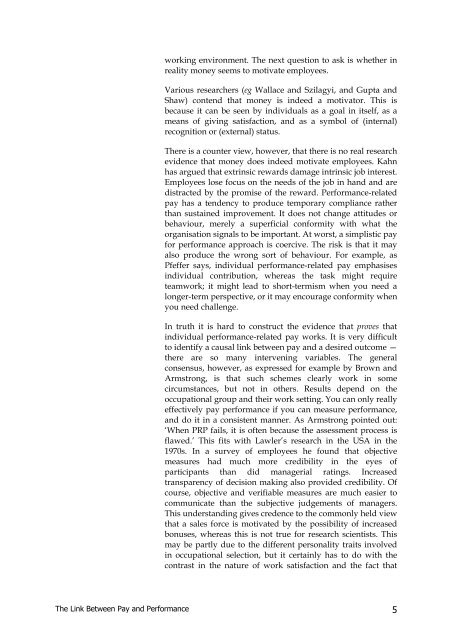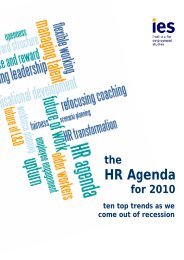The link between pay and performance - The Institute for ...
The link between pay and performance - The Institute for ...
The link between pay and performance - The Institute for ...
Create successful ePaper yourself
Turn your PDF publications into a flip-book with our unique Google optimized e-Paper software.
working environment. <strong>The</strong> next question to ask is whether inreality money seems to motivate employees.Various researchers (eg Wallace <strong>and</strong> Szilagyi, <strong>and</strong> Gupta <strong>and</strong>Shaw) contend that money is indeed a motivator. This isbecause it can be seen by individuals as a goal in itself, as ameans of giving satisfaction, <strong>and</strong> as a symbol of (internal)recognition or (external) status.<strong>The</strong>re is a counter view, however, that there is no real researchevidence that money does indeed motivate employees. Kahnhas argued that extrinsic rewards damage intrinsic job interest.Employees lose focus on the needs of the job in h<strong>and</strong> <strong>and</strong> aredistracted by the promise of the reward. Per<strong>for</strong>mance-related<strong>pay</strong> has a tendency to produce temporary compliance ratherthan sustained improvement. It does not change attitudes orbehaviour, merely a superficial con<strong>for</strong>mity with what theorganisation signals to be important. At worst, a simplistic <strong>pay</strong><strong>for</strong> <strong>per<strong>for</strong>mance</strong> approach is coercive. <strong>The</strong> risk is that it mayalso produce the wrong sort of behaviour. For example, asPfeffer says, individual <strong>per<strong>for</strong>mance</strong>-related <strong>pay</strong> emphasisesindividual contribution, whereas the task might requireteamwork; it might lead to short-termism when you need alonger-term perspective, or it may encourage con<strong>for</strong>mity whenyou need challenge.In truth it is hard to construct the evidence that proves thatindividual <strong>per<strong>for</strong>mance</strong>-related <strong>pay</strong> works. It is very difficultto identify a causal <strong>link</strong> <strong>between</strong> <strong>pay</strong> <strong>and</strong> a desired outcome —there are so many intervening variables. <strong>The</strong> generalconsensus, however, as expressed <strong>for</strong> example by Brown <strong>and</strong>Armstrong, is that such schemes clearly work in somecircumstances, but not in others. Results depend on theoccupational group <strong>and</strong> their work setting. You can only reallyeffectively <strong>pay</strong> <strong>per<strong>for</strong>mance</strong> if you can measure <strong>per<strong>for</strong>mance</strong>,<strong>and</strong> do it in a consistent manner. As Armstrong pointed out:‘When PRP fails, it is often because the assessment process isflawed.’ This fits with Lawler’s research in the USA in the1970s. In a survey of employees he found that objectivemeasures had much more credibility in the eyes ofparticipants than did managerial ratings. Increasedtransparency of decision making also provided credibility. Ofcourse, objective <strong>and</strong> verifiable measures are much easier tocommunicate than the subjective judgements of managers.This underst<strong>and</strong>ing gives credence to the commonly held viewthat a sales <strong>for</strong>ce is motivated by the possibility of increasedbonuses, whereas this is not true <strong>for</strong> research scientists. Thismay be partly due to the different personality traits involvedin occupational selection, but it certainly has to do with thecontrast in the nature of work satisfaction <strong>and</strong> the fact that<strong>The</strong> Link Between Pay <strong>and</strong> Per<strong>for</strong>mance 5
















